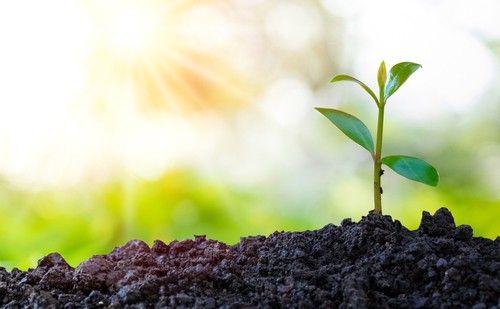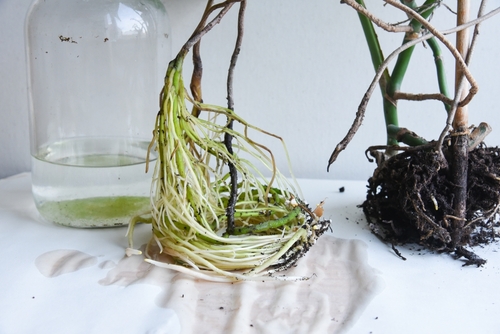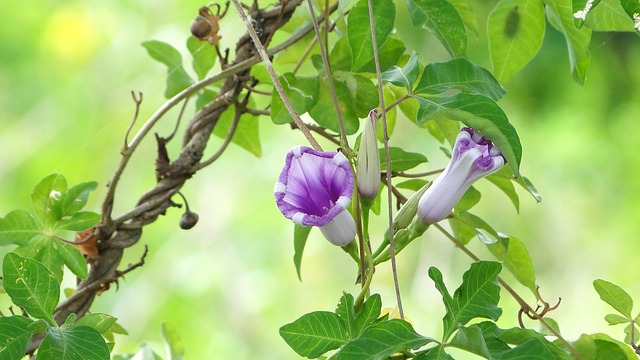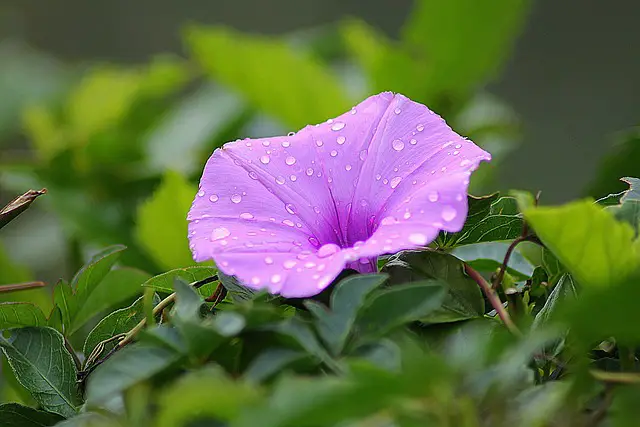Morning glory plants are a popular addition to gardens and landscapes, known for their beautiful, funnel-shaped flowers that bloom in a variety of colors.
However, gardeners may sometimes notice their morning glory leaves turning yellow, which can be a cause for concern. Understanding the reasons behind this discoloration is crucial to ensuring the health and vitality of the plant.
There are several common causes for yellowing leaves in morning glory plants. One of the most likely culprits is over or under watering, as morning glories require a consistent level of moisture to thrive.
Nutrient deficiencies, pests, and fungal diseases can also contribute to yellowing leaves. Proper care, including regular fertilization and pruning, is essential to keeping morning glory plants healthy and vibrant.
Key Takeaways
- Morning glory plants may develop yellowing leaves due to a variety of factors, including over or under watering, nutrient deficiencies, pests, and fungal diseases.
- Regular care, such as fertilization and pruning, is essential to maintaining the health of morning glory plants.
- Identifying the cause of yellowing leaves and taking appropriate action can help ensure the continued vitality and beauty of morning glory plants.
Also don’t miss:
- Why Are My Lavender Leaves Turning Yellow?
- Why Are My Jasmine Leaves Turning Yellow?
- Why Are My Fuchsia Leaves Turning Yellow?
Understanding Morning Glory Plants

Morning glory plants are hardy annuals that belong to the Convolvulaceae family. The most common species of morning glory is the Ipomoea purpurea, which is a climbing vine that produces beautiful trumpet-shaped flowers. Morning glory plants are popular among gardeners because of their attractive flowers, fast growth, and ease of care.
Morning glory plants are hardy and can tolerate a wide range of growing conditions. They prefer full sun and well-drained soil, but they can also grow in partial shade and poor soil.
Morning glory plants are annuals, which means they complete their life cycle within one year. They grow quickly and can reach a height of up to 10 feet in a single growing season.
Morning glory plants are also known for their invasive nature. They can quickly take over an area and choke out other plants. Therefore, it is essential to keep them under control by pruning and removing any unwanted growth.
One of the most common problems that gardeners face with morning glory plants is yellowing leaves. Yellowing leaves on morning glory plants can be caused by a variety of factors, including over-watering, under-watering, poor soil quality, lack of sunlight, pests, and diseases.
It is essential to identify the cause of the problem to take appropriate action and prevent further damage to the plant.
Morning Glory Leaves Turning Yellow – 5 Common Problems
Morning Glory plants are known for their beautiful, vibrant blooms and lush green foliage. However, if you notice that the leaves of your Morning Glory plant are turning yellow, it could be a sign of an underlying problem. Here are some common causes for yellowing leaves in Morning Glory plants.
1. Watering Issues
Overwatering or underwatering can cause yellowing leaves in Morning Glory plants. If the soil is too wet, it can lead to root rot, which can cause the leaves to turn yellow and wilt.
On the other hand, if the soil is too dry, the leaves can dry out and turn yellow. It’s important to maintain a consistent watering schedule and ensure that the soil is well-draining.
2. Sunlight Exposure

Morning Glory plants need plenty of sunlight to thrive. If they are not getting enough sunlight, the leaves can turn yellow and the plant can become weak and stunted. Make sure that your Morning Glory plant is getting at least 6 hours of direct sunlight per day.
3. Temperature Effects
Morning Glory plants are sensitive to extreme temperatures. If the plant is exposed to very cold temperatures, it can cause the leaves to turn yellow and fall off. Similarly, if the plant is exposed to very hot temperatures, it can cause the leaves to dry out and turn yellow.
4. Pest Infestation
Pests such as spider mites and aphids can cause yellowing leaves in Morning Glory plants. These pests feed on the plant’s sap, which can cause the leaves to turn yellow and develop discoloration or leaf spots. Regularly inspect your plant for signs of pest infestation and take appropriate measures to control them.
5. Fungal Diseases
Fungal diseases such as powdery mildew and leaf spot can also cause yellowing leaves in Morning Glory plants. These diseases thrive in warm, humid conditions and can cause the leaves to develop yellow spots or patches. Regularly inspect your plant for signs of fungal diseases and take appropriate measures to control them.
Nutrient Deficiencies and Their Effects
Morning glory leaves turning yellow is often a sign of nutrient deficiencies. Here are some of the most common nutrient deficiencies that can cause yellowing of morning glory leaves:
1. Nitrogen Deficiency
Nitrogen is an essential nutrient for plant growth. If the morning glory plant is not getting enough nitrogen, the leaves will start to turn yellow. Nitrogen deficiency can cause stunted growth, reduced flower production, and weak stems.
2. Potassium Deficiency

Potassium is another essential nutrient for plant growth. If the morning glory plant is not getting enough potassium, the leaves will start to turn yellow. Potassium deficiency can cause reduced flower production, weak stems, and poor root development.
3. Magnesium Deficiency
Magnesium is a key component of chlorophyll, which is responsible for the green color of leaves. If the morning glory plant is not getting enough magnesium, the leaves will start to turn yellow. Magnesium deficiency can cause chlorosis, which is a condition where the leaves turn yellow but the veins remain green.
4. Iron Deficiency
Iron is another important nutrient for plant growth. If the morning glory plant is not getting enough iron, the leaves will start to turn yellow. Iron deficiency can cause chlorosis, but the yellowing will occur between the veins of the leaf rather than across the entire leaf.
It is important to note that too much fertilizer can also cause yellowing of morning glory leaves. Over-fertilization can lead to nutrient imbalances that can cause yellowing and other problems. It is best to follow the recommended fertilizer application rates and schedules to avoid over-fertilization.
Identifying and Treating Pests
Morning glory plants are susceptible to a variety of pests that can cause yellowing leaves. Identifying and treating these pests is crucial to maintaining a healthy plant. Here are some common pests that affect morning glory plants and how to treat them:
1. Cotton Aphids
Cotton aphids are small, soft-bodied insects that suck the sap out of the plant, causing yellowing leaves. They can be identified by their cotton-like appearance and come in various colors. To control cotton aphids, use a strong jet of water to knock them off the plant. Alternatively, apply neem oil to the plant, which will suffocate the aphids.
2. Leafcutters
Leafcutters are small, black or brown beetles that chew holes in the leaves of morning glory plants. They can cause significant damage to the plant, leading to yellowing leaves. To control leafcutters, remove any damaged leaves and apply a pesticide that contains carbaryl or malathion.
3. Leaf Miner

Leaf miners are small, black flies that lay their eggs on the leaves of morning glory plants. The larvae burrow into the leaves, causing yellowing and brown spots. To control leaf miners, remove any damaged leaves and apply a pesticide that contains imidacloprid or spinosad.
4. Pest Control
To prevent pests from infesting morning glory plants, it is important to practice good pest control. This includes regularly inspecting the plant for signs of pests, removing any damaged leaves, and applying pesticides as needed. It is also important to keep the plant healthy by providing adequate water and nutrients.
5. Neem Oil
Neem oil is a natural pesticide that can be used to control a variety of pests, including cotton aphids. It works by suffocating the pests and disrupting their reproductive cycle.
To use neem oil, dilute it with water according to the instructions on the label and apply it to the plant with a sprayer. Repeat the application every seven to ten days until the pests are under control.
Identifying and Treating Fungal Diseases
Morning glory plants are susceptible to various fungal diseases that can cause their leaves to turn yellow. Identifying and treating these diseases is essential to keep your plants healthy and thriving.
Rust
Rust is a fungal disease that can cause yellowing leaves on morning glory plants. To diagnose whether your morning glory plants have rust or not, look closely at the leaves.
There are going to be powdery pustules on the backside of the leaf. They are what cause the leaf of Morning Glory to turn yellow or orange. If you notice these pustules, it’s important to act quickly to prevent the disease from spreading.
To treat rust, remove the infected leaves and dispose of them immediately. You can also use a fungicide to control the disease. Apply the fungicide according to the manufacturer’s instructions, and be sure to cover the entire plant thoroughly.
Leaf Spot Fungus
Leaf spot fungus is another common fungal disease that can cause morning glory leaves to turn yellow. This disease is caused by various fungi that can infect the leaves of the plant, causing small, dark spots to appear. Over time, these spots can grow and merge, causing the entire leaf to turn yellow.
To treat leaf spot fungus, remove the infected leaves and dispose of them immediately. You can also use a fungicide to control the disease. Apply the fungicide according to the manufacturer’s instructions, and be sure to cover the entire plant thoroughly.
Root Rot

Root rot is a fungal disease that can cause morning glory plants to wilt and turn yellow. This disease is caused by various fungi that can infect the roots of the plant, causing them to rot. Over time, the plant will become weak and eventually die.
To treat root rot, remove the infected roots and dispose of them immediately. You can also repot your plant in a fresh container with sterile potting soil. Be sure to water your plant carefully, avoiding overwatering, which can contribute to the development of root rot.
Proper Care for Morning Glory Plants
Morning glory plants are relatively easy to care for, but they do require specific conditions to thrive. Here are some tips for proper care:
1. Water
Morning glory plants need regular watering, especially during dry spells. However, overwatering can cause root rot and other issues. It is important to strike a balance between keeping the soil moist and not letting it get too wet. A good rule of thumb is to water deeply once a week, or more often during hot, dry weather.
2. Sunlight
Morning glory plants need plenty of sunlight to grow and bloom. They prefer full sun or at least six hours of direct sunlight per day. If the plant is not getting enough sunlight, the leaves may turn yellow or the plant may not flower.
3. Soil and Drainage
Morning glory plants prefer well-draining soil. If the soil is too heavy or compacted, it can lead to root rot or other issues. Adding compost or other organic matter to the soil can improve drainage and provide nutrients for the plant.
4. Air Circulation
Good air circulation is important for morning glory plants. If the plant is crowded or growing in a spot with poor air flow, it can be more susceptible to disease and other issues. Pruning the plant to improve air circulation can help prevent problems.
5. Cold Winters
Morning glory plants are typically grown as annuals, but in warmer climates, they may survive as perennials. If the plant is exposed to cold temperatures or frost, it may die back or not grow as well the following year.
6. Natural Causes of Yellow Leaves
Yellow leaves on morning glory plants can be a natural part of the plant’s growth cycle, especially as the seasons change. However, if the leaves are turning yellow and falling off in large numbers, it may be a sign of a problem.
Conclusion

Morning Glory leaves turning yellow can be a sign of stress for the plant. It is important to understand the potential reasons for this to happen and take appropriate action to remedy the situation.
One possible reason for yellowing leaves is lack of sunlight. Morning Glory plants need full sun to thrive, so if they are not getting enough, their leaves may turn yellow. Another reason could be exposure to very cold temperatures, which can damage the leaves and cause them to turn yellow.
Over-fertilization can also cause yellowing leaves. It is important to follow the recommended fertilization schedule for Morning Glory plants and not overdo it. Nutrient deficiency can also be a cause of yellowing leaves, so it is important to ensure that the plant is getting the necessary nutrients.
Disease can also be a factor in yellowing leaves. Excessively wet conditions and poor air circulation can promote leaf viruses, causing white powdery pustules on the leaf undersides and yellow/orange discoloration. Pruning infected leaves and refraining from overhead watering can help prevent this.
Frequently Asked Questions
What causes morning glory leaves to turn yellow?
Yellowing of morning glory leaves can be caused by various factors such as overwatering, underwatering, nutrient deficiency, pests, and diseases. It is important to identify the cause to prevent further damage to the plant.
Are morning glory leaves supposed to turn yellow?
No, morning glory leaves are not supposed to turn yellow. Healthy morning glory leaves should be green and vibrant.
How can I prevent morning glory leaves from turning yellow?
To prevent morning glory leaves from turning yellow, ensure that the plant is getting adequate sunlight, water, and nutrients. Avoid overwatering or underwatering the plant, and keep an eye out for pests and diseases.
What nutrient deficiency causes yellowing of morning glory leaves?
A deficiency in nitrogen, iron, or magnesium can cause yellowing of morning glory leaves. It is important to provide the plant with the necessary nutrients to prevent yellowing.
Can overwatering cause morning glory leaves to turn yellow?
Yes, overwatering can cause morning glory leaves to turn yellow. It can lead to root rot, which can affect the plant’s ability to absorb nutrients and water, resulting in yellowing of the leaves.
How often should I water morning glories to prevent yellowing of leaves?
Morning glories should be watered once a week, providing about 1 inch (2.5 cm) of water. If there is rainfall, adjust watering accordingly. Avoid overwatering, as it can lead to yellowing of the leaves.

Hey, I’m Lisa and I’ve been an avid gardener for over 30 years. I love writing, talking and living in the garden! Feel free to connect with me on my socials below


